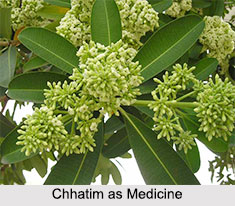 Chhatim is a glabrous medicinal tree native to India. The bark of Alstonia scholaris is very thick and spongy; hence the tree has received the names of "Visalatvak", "Vrihattvak", etc. It is described as tonic, alterative and useful in fever and skin diseases.
Chhatim is a glabrous medicinal tree native to India. The bark of Alstonia scholaris is very thick and spongy; hence the tree has received the names of "Visalatvak", "Vrihattvak", etc. It is described as tonic, alterative and useful in fever and skin diseases.
Dose of Chhatim in Medicine
Sushruta gives the following formula for use in catarrhal fever. Take the bark of Alstonia scholaris, gulancha, neem bark and the bark of Betula Bhojpattra, equal parts, in all 2 tolas and prepare a decoction in the usual way. It enters into the composition of several formulae for skin diseases. The following is an illustration:
Amritashtaka Pachana: Take the bark of Alstonia scholaris, gulancha, leaves of Justicia Adhatoda (vasaka) and Trichosanthes dioica (patola), tubers of Cyperus rotundus (mustaka ), Calumus Rotnng (vetra), catechu and neem leaves, and prepare a decoction in the usual way.
This article is a stub. You can enrich by adding more information to it. Send your Write Up to content@indianetzone.com
Related Articles
Ayurveda
Ayurveda Medication
Elements of Ayurveda
Concepts of Ayurveda
Ancient Literature of Ayurveda
Sushruta Samhita
Classification of Medicine
Properties of Material Objects and its Effect on Human Body




















